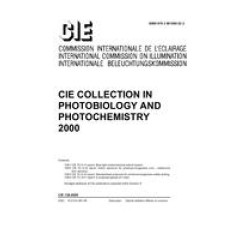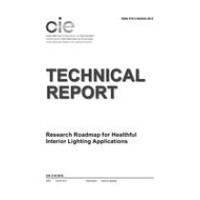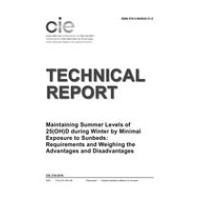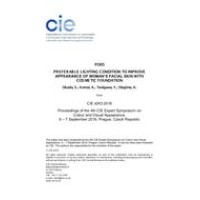CIE 138-2000
- CIE Collection in photobiology and photochemistry 2000
- standard by Commission Internationale de L'Eclairage, 01/01
- Category: CIE
$89.04
$45.00
This volume contains short Technical Reports prepared by various Technical Committees within Division 6.
138/1 Blue Light Photochemical Retinal HazardThe results of studies of acute photochemical retinal injury, frequently referred to as the "blue light hazard (BLH)" are described in this technical report. The BLH results from a photochemical injury to the human retina and is termed by ophthalmologists "photoretinitis." The studies were performed by a number of scientists, these works provided the basis for threshold limit values (TLV) and the BLH action spectrum recommended by the American Conference of Governmental Industrial Hygienists (ACGIH) in the 1970's, and more recently, after completion of the work of TC 6-14, by the International Commission on Non-Ionizing Radiation Protection (ICNIRP).
The potential for photoretinitis resulting from viewing the sun, tungsten-halogen lamps, high intensity discharge lamps, xenon short-arc lamps, welding arcs, etc., is provided in this report. Means and methods to evaluate potential BLH were studied by the CIE committee and one technique employing the ACGIH TLV is proposed for general use.
Both national and international standards for eye protectors exist. The recognized international standard (ISO 4850: Personal Eye Protectors for Welding and Related Techniques - Filters - Utilization and Transmittance Requirements) is followed internationally. It is concluded that actual specifications for maximal blue-light transmittance may be a desirable addition to future editions of eye protection standards.
138/2 Action Spectrum for Photocarcinogenesis (Non - Melanoma Skin Cancers)
Solar ultraviolet radiation (UVR) is recognized as a major cause of non-melanoma skin cancer in man. Skin cancer occurs most frequently in the most heavily exposed areas and correlates with degree of outdoor exposure. Describing the relationship of exposure (dose) to risk (skin cancer) requires the availability of a biological hazard function or action spectrum for photocarcinogenesis. This is true for estimating risks from sunlight under a variety of conditions, and from optical radiation from artificial sources. As classically defined and executed in other systems, directly determining an action spectrum involves monochromatic radiation; very few data points for photocarcinogenesis would ever be available using that approach. However, using a variety of sources capable of repeatedly exposing relatively large surface areas, candidate weighting functions can be tested, and response curves can be fitted to sizeable data bases. This committee report proposes the adoption of an action spectrum (weighting function) derived from experimental laboratory data and modified to estimate the non-melanoma tumor response in human skin. On a log-linear plot, the weighting function follows the calculated SCUP-h curve from 280 nm to 340 nm, and then a straight interpolation line from 340 nm to 400 nm (at effectiveness 3,94 · 10-4). The experimental data are sufficient for estimating effectiveness down to about 250 nm, but experimental data are not sufficient for specifying effectiveness above 400 nm.
138/3 Standardized Protocols for Photocarcinogenesis Safety Testing
Solar ultraviolet radiation (UVR) is recognized as a major cause of non-melanoma skin cancer in man. Skin cancer occurs most frequently in the most heavily exposed areas and correlates with degree of outdoor exposure. The incidence of skin cancer is also increased by contact with photosensitizing drugs and chemicals such as psoralens, coal tars and petroleum stocks. Other substances which do not act as photosensitizers, such as immunosuppressants taken by organ transplant recipients, also increase the risk of skin cancer. The U.S. Food and Drug Administration requires on a case-by-case basis that the risk of enhanced photocarcinogenesis is assessed for many classes of drugs. Health Canada's Therapeutic Products Programme has issued a Notice of Intent to regulate pharmaceutical products which may enhance carcinogenicity of the skin induced by ultraviolet radiation. Other national regulatory agencies review such data when they exist, but their own requirements emphasize batteries of short-term in vitro and in vivo tests. While they may support drug development strategies, short term tests have yet to be validated as predictors of the ability of drugs or chemicals to enhance photocarcinogenesis. Published protocols now describe study designs and procedures capable of determining whether test agents enhance the rate of formation of UVR-induced skin tumors.
138/4 A Proposed Global UV Index
Increasing public concern over declining ozone levels and the resultant ultraviolet (UV) radiation reaching the earth has brought about a need to communicate daily information to the public in a credible and understandable manner. Several dozen countries have implemented a wide variety of UV index programs, utilizing different scales and methods of communication. This has created confusion for several years. A single scale for communicating UV dose rate to the public has been proposed and endorsed by the World Health Organization (WHO), the World Meteorological Organization (WMO), and the International Commission on Non-Ionizing Radiation Protection (ICNIRP). This scale may also be useful for communication within the scientific community. The scale is addressed and summarized here. A definition of the Global UV Index is recommended, for addition to the CIE International Lighting Vocabulary.
138/1 Blue Light Photochemical Retinal HazardThe results of studies of acute photochemical retinal injury, frequently referred to as the "blue light hazard (BLH)" are described in this technical report. The BLH results from a photochemical injury to the human retina and is termed by ophthalmologists "photoretinitis." The studies were performed by a number of scientists, these works provided the basis for threshold limit values (TLV) and the BLH action spectrum recommended by the American Conference of Governmental Industrial Hygienists (ACGIH) in the 1970's, and more recently, after completion of the work of TC 6-14, by the International Commission on Non-Ionizing Radiation Protection (ICNIRP).
The potential for photoretinitis resulting from viewing the sun, tungsten-halogen lamps, high intensity discharge lamps, xenon short-arc lamps, welding arcs, etc., is provided in this report. Means and methods to evaluate potential BLH were studied by the CIE committee and one technique employing the ACGIH TLV is proposed for general use.
Both national and international standards for eye protectors exist. The recognized international standard (ISO 4850: Personal Eye Protectors for Welding and Related Techniques - Filters - Utilization and Transmittance Requirements) is followed internationally. It is concluded that actual specifications for maximal blue-light transmittance may be a desirable addition to future editions of eye protection standards.
138/2 Action Spectrum for Photocarcinogenesis (Non - Melanoma Skin Cancers)
Solar ultraviolet radiation (UVR) is recognized as a major cause of non-melanoma skin cancer in man. Skin cancer occurs most frequently in the most heavily exposed areas and correlates with degree of outdoor exposure. Describing the relationship of exposure (dose) to risk (skin cancer) requires the availability of a biological hazard function or action spectrum for photocarcinogenesis. This is true for estimating risks from sunlight under a variety of conditions, and from optical radiation from artificial sources. As classically defined and executed in other systems, directly determining an action spectrum involves monochromatic radiation; very few data points for photocarcinogenesis would ever be available using that approach. However, using a variety of sources capable of repeatedly exposing relatively large surface areas, candidate weighting functions can be tested, and response curves can be fitted to sizeable data bases. This committee report proposes the adoption of an action spectrum (weighting function) derived from experimental laboratory data and modified to estimate the non-melanoma tumor response in human skin. On a log-linear plot, the weighting function follows the calculated SCUP-h curve from 280 nm to 340 nm, and then a straight interpolation line from 340 nm to 400 nm (at effectiveness 3,94 · 10-4). The experimental data are sufficient for estimating effectiveness down to about 250 nm, but experimental data are not sufficient for specifying effectiveness above 400 nm.
138/3 Standardized Protocols for Photocarcinogenesis Safety Testing
Solar ultraviolet radiation (UVR) is recognized as a major cause of non-melanoma skin cancer in man. Skin cancer occurs most frequently in the most heavily exposed areas and correlates with degree of outdoor exposure. The incidence of skin cancer is also increased by contact with photosensitizing drugs and chemicals such as psoralens, coal tars and petroleum stocks. Other substances which do not act as photosensitizers, such as immunosuppressants taken by organ transplant recipients, also increase the risk of skin cancer. The U.S. Food and Drug Administration requires on a case-by-case basis that the risk of enhanced photocarcinogenesis is assessed for many classes of drugs. Health Canada's Therapeutic Products Programme has issued a Notice of Intent to regulate pharmaceutical products which may enhance carcinogenicity of the skin induced by ultraviolet radiation. Other national regulatory agencies review such data when they exist, but their own requirements emphasize batteries of short-term in vitro and in vivo tests. While they may support drug development strategies, short term tests have yet to be validated as predictors of the ability of drugs or chemicals to enhance photocarcinogenesis. Published protocols now describe study designs and procedures capable of determining whether test agents enhance the rate of formation of UVR-induced skin tumors.
138/4 A Proposed Global UV Index
Increasing public concern over declining ozone levels and the resultant ultraviolet (UV) radiation reaching the earth has brought about a need to communicate daily information to the public in a credible and understandable manner. Several dozen countries have implemented a wide variety of UV index programs, utilizing different scales and methods of communication. This has created confusion for several years. A single scale for communicating UV dose rate to the public has been proposed and endorsed by the World Health Organization (WHO), the World Meteorological Organization (WMO), and the International Commission on Non-Ionizing Radiation Protection (ICNIRP). This scale may also be useful for communication within the scientific community. The scale is addressed and summarized here. A definition of the Global UV Index is recommended, for addition to the CIE International Lighting Vocabulary.
 PDF
PDF
All of our standards document are available in PDF (Portable Document Format), an electronic, downloadable format.You will be able to download the file in your account downloads.
 Multi-User Access
Multi-User Access
After purchasing, you have the ability to assign each license to a specific user.
 Printable
Printable
At any time, you are permitted to make printed copies for your and your members' reference use.





